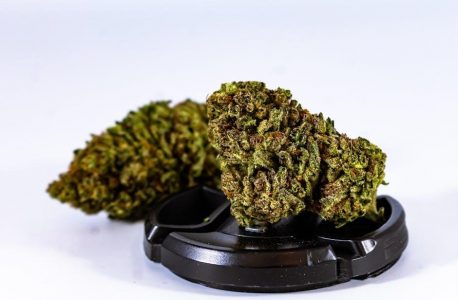How to Make Marijuana Edibles: The Ultimate Guide
Explore the comprehensive guide on creating marijuana edibles‚ covering essential steps‚ safety tips‚ and recipes. Learn about cannabis basics‚ decarboxylation‚ infusion methods‚ and proper dosing to craft delicious and potent treats. Perfect for both novices and experienced edible enthusiasts.
- Understand cannabis basics and potency calculation.
- Master decarboxylation for maximum effectiveness.
- Discover infusion techniques for oils and butters.
- Explore simple yet flavorful recipes.
- Learn safety tips for consumption and storage.
A must-have resource for anyone exploring cannabis edibles.
Marijuana edibles are food or drink products infused with cannabis‚ offering a smoke-free alternative for consuming THC or CBD. These treats range from classic baked goods like brownies and cookies to innovative creations like gummies‚ chocolates‚ and even savory dishes. Unlike smoking‚ edibles provide a discreet and flavorful way to enjoy cannabis‚ making them a popular choice for both medical and recreational users.
Edibles work differently from smoked cannabis because they are metabolized by the liver‚ which converts THC into a more potent compound. This process results in a slower onset of effects‚ typically within 30 minutes to 2 hours‚ but the high can last much longer—often 6 to 8 hours or more. This unique experience makes edibles appealing for those seeking prolonged relief or relaxation.
The rise of edibles has led to a vibrant culinary scene‚ with chefs and home cooks experimenting with cannabis-infused recipes. Legalization in many regions has further fueled their popularity‚ making them accessible to a broader audience. Whether you’re looking to ease pain‚ reduce anxiety‚ or simply enjoy a new way to unwind‚ marijuana edibles offer a versatile and convenient option.
This guide will walk you through everything you need to know to make marijuana edibles safely and effectively‚ ensuring a enjoyable and controlled experience.
Understanding the Basics of Cannabis
Before diving into making marijuana edibles‚ it’s essential to understand the fundamentals of cannabis. Cannabis is a plant containing over 100 cannabinoids‚ with THC (tetrahydrocannabinol) and CBD (cannabidiol) being the most prominent. THC is the psychoactive compound responsible for the “high‚” while CBD offers therapeutic benefits without intoxication. The ratio of these cannabinoids determines the effects of the final product.
The cannabis plant also contains terpenes‚ which are aromatic compounds that influence flavor and potency. Understanding how these components interact is crucial for creating edibles with desired effects. Additionally‚ the concept of the endocannabinoid system (ECS) explains how cannabis interacts with the human body‚ highlighting its potential for medical and recreational use.
Knowing the difference between indica‚ sativa‚ and hybrid strains can also guide your edible-making process. Indica strains are often associated with relaxation‚ while sativas are known for their energizing effects. Hybrids offer a balanced experience. This foundational knowledge helps in selecting the right strain for your edibles and achieving the intended outcome.
Understanding cannabis potency is vital for safety and efficacy. This involves measuring THC content and calculating proper dosages‚ which are critical steps in making edibles. Without this knowledge‚ the risk of overconsumption or underwhelming effects increases. Mastery of these basics ensures a safe and enjoyable edible experience.
Safety Considerations
When making marijuana edibles‚ safety is paramount to ensure a positive experience. Start by understanding the potency of your cannabis and calculate accurate doses to avoid overconsumption. Begin with low doses‚ especially for first-time users‚ and wait at least 60-90 minutes to feel effects before consuming more.
Use a reliable dosage calculator to determine THC content in your edibles. Proper storage is crucial—keep edibles in childproof containers and label them clearly to prevent accidental ingestion. Always follow proper food safety guidelines to avoid contamination.
Be aware of the legal implications in your area‚ as laws regarding cannabis use and edibles vary. Consume responsibly and never operate machinery or drive under the influence. For health considerations‚ certain groups‚ like adolescents‚ pregnant women‚ and those with pre-existing conditions‚ should consult a healthcare professional before using edibles.
Remember‚ edibles can be unpredictable due to varying metabolisms and tolerances. Start small‚ stay informed‚ and prioritize your health and safety above all.
- Always test THC levels for accurate dosing.
- Store edibles safely and label them clearly.
- Begin with low doses and wait for effects.
- Follow local laws and regulations.
- Consult a healthcare provider if necessary.
Safety ensures a enjoyable and responsible edible experience.
Legal Considerations
Before making marijuana edibles‚ it is crucial to understand the legal landscape in your area. Cannabis laws vary significantly by region‚ and the legality of producing and consuming edibles depends on local regulations. In some places‚ cannabis is legal for medical or recreational use‚ while in others‚ it remains strictly prohibited. Always verify the specific laws in your jurisdiction to avoid legal consequences.
In areas where cannabis is legal‚ ensure you comply with regulations regarding possession limits‚ cultivation‚ and edibles production. For example‚ some regions require licenses for commercial edible production‚ while homemade edibles may be permitted for personal use. Additionally‚ age restrictions often apply‚ and distributing edibles to minors is illegal.
Be aware of cross-border or interstate transport laws‚ as moving cannabis products‚ including edibles‚ can lead to severe penalties; Privacy is another concern—ensure your edible production and storage spaces are secure to prevent unauthorized access or legal disputes.
- Verify local cannabis laws before proceeding.
- Comply with age restrictions and possession limits.
- Avoid transporting edibles across borders or states.
- Secure your production and storage areas.
- Consult legal advice if unsure about regulations.
Adhering to legal guidelines ensures a safe and lawful edible-making experience.
Choosing the Right Strain
Selecting the right cannabis strain is a critical step in making marijuana edibles. Different strains offer unique effects‚ flavors‚ and potencies‚ so understanding their characteristics will help you achieve the desired outcome. Strains are typically categorized as indica‚ sativa‚ or hybrid‚ each with distinct properties.
Indica strains are known for their relaxing‚ sedative effects‚ making them ideal for those seeking calm or pain relief. Sativa strains‚ on the other hand‚ are energizing and mentally stimulating‚ often used for creativity or focus. Hybrid strains combine these traits‚ offering a balanced experience. Additionally‚ high-CBD strains are preferred for their therapeutic benefits without psychoactive effects.
Consider the terpene profile of the strain‚ as these compounds influence flavor and aroma. For edibles‚ strains with complementary terpenes can enhance the taste and overall experience. If you’re new to edibles‚ start with a low-potency strain to avoid overwhelming effects.
- Choose indica for relaxation‚ sativa for energy‚ or hybrid for balance.
- Select high-CBD strains for therapeutic benefits without psychoactive effects.
- Consider terpene profiles for flavor and aroma.
- Begin with low-potency strains for safer dosing.
Research or consult with a dispensary expert to find the best strain for your edible-making goals.
Preparing Your Cannabis
Preparing your cannabis is a crucial step in making edibles. It involves decarboxylation‚ which activates the THC‚ ensuring the edibles are potent. Heat the cannabis at 220-240°F for 20-30 minutes. After decarboxylation‚ infuse the cannabis into butter or oil. Use a 1:1 ratio of cannabis to butter or oil and simmer for 2-3 hours‚ then strain using cheesecloth. For convenience‚ a slow cooker can be used for infusion. Store the infused products in airtight containers and label them clearly. Always comply with local laws and calculate dosages carefully for safe consumption.
- Decarboxylate cannabis at 220-240°F for 20-30 minutes.
- Infuse into butter or oil using a 1:1 ratio and simmer for 2-3 hours.
- Strain the mixture with cheesecloth to remove plant material.
- Use a slow cooker for easier infusion.
- Store infused products in airtight containers and label clearly.
- Comply with local laws and calculate dosages carefully.
Proper preparation ensures effective and safe edibles.
Essential Tools and Ingredients
To make marijuana edibles‚ you’ll need the right tools and ingredients. Start with a reliable digital scale for precise measurements and a baking sheet for decarboxylation. A grinder or food processor will help break down the cannabis evenly. Cheesecloth or a fine-mesh strainer is essential for filtering infused oils and butters. Use a double boiler or slow cooker for gentle heating during infusion. Glass jars with lids are perfect for storing infused products‚ and labels will help you keep track of potency and ingredients.
- Digital scale for accurate measurements.
- Baking sheet and oven for decarboxylation.
- Grinder or food processor for breaking down cannabis.
- Cheesecloth or fine-mesh strainer for filtering.
- Double boiler or slow cooker for infusion.
- Glass jars with lids for storage.
- Labels for tracking potency and ingredients.
Key ingredients include high-quality cannabis‚ neutral-tasting oil or butter‚ and basic baking supplies like flour‚ sugar‚ and leavening agents. Optional add-ins like flavorings or emulsifiers can enhance texture and taste. Always use laboratory-tested cannabis for consistency and safety.
Step-by-Step Recipe Guide
Creating marijuana edibles involves a simple‚ step-by-step process that ensures potency and flavor. Start by decarboxylating your cannabis in the oven at 220°F (104°C) for 20-30 minutes to activate the THC. Grind the decarboxylated cannabis finely and mix it with oil or butter in a double boiler or slow cooker. Heat the mixture on low for 2-3 hours‚ stirring occasionally‚ until the oil takes on a green hue and the cannabis is fully infused.
- Decarboxylate cannabis to activate THC.
- Infuse cannabis into oil or butter.
- Strain the mixture through cheesecloth into a glass jar.
- Use the infused oil or butter in recipes like brownies‚ cookies‚ or gummies.
- Test potency by using small amounts of infused product.
For baked goods‚ replace regular butter or oil with the infused version. For gummies‚ mix the infused oil with gelatin and fruit juice‚ then pour into molds and chill until set. Always label and date your creations for safe consumption. This guide provides a foundation for crafting delicious and effective marijuana edibles‚ whether you’re a novice or an experienced chef.
Proper Food Safety and Storage
Proper food safety and storage are crucial when making marijuana edibles to ensure quality‚ potency‚ and safety. Always handle ingredients hygienically‚ and store edibles in airtight containers to prevent contamination and spoilage. Keep edibles away from direct sunlight‚ heat sources‚ and moisture‚ as these can degrade cannabinoids and affect potency.
- Labeling: Clearly label all edibles with the date made‚ dosage‚ and ingredients to avoid accidental consumption and ensure proper tracking.
- Storage Conditions: Store edibles in a cool‚ dark place‚ such as a pantry or refrigerator‚ depending on the type of food. Refrigeration can extend shelf life‚ while freezing preserves potency for months.
- Separation: Keep edibles separate from regular food to prevent mistaken ingestion‚ especially in households with children or pets.
- Best Practices: Use clean utensils and surfaces during preparation‚ and avoid cross-contamination with non-infused foods. Discard any edibles that show signs of spoilage‚ such as mold or an off smell.
For baked goods‚ store them in airtight containers at room temperature for up to 5 days or freeze for up to 3 months. Candies and gummies can be stored in a cool‚ dry place for several weeks. Always follow safe food handling practices to enjoy your edibles responsibly and effectively.
Calculating Potency and Dosage
Accurately calculating potency and dosage is essential for safe and enjoyable marijuana edibles. Start by determining the THC content of your cannabis. If using flower‚ check the percentage on the packaging or test it. For concentrates‚ follow the product’s label. Next‚ calculate the total THC in your recipe by multiplying the cannabis amount by its potency percentage.
Divide the total THC by the number of servings to find per-serving dosage. For example‚ if 1 gram of 20% THC bud is used in 24 cookies‚ each cookie has 20mg of THC (1‚000mg / 24). Adjust portion sizes or cannabis amounts to achieve desired dosages. Use an edible dosage calculator for precision.
- Start Low: Begin with 5-10mg THC per serving‚ especially for new users.
- Label Clearly: Mark edibles with THC content to prevent accidental overconsumption.
- Test First: Consume a small portion and wait 60-90 minutes to gauge effects before eating more.
- Store Safely: Keep edibles secure to avoid unintended access by children or pets.
Calculating potency ensures consistent effects‚ making edibles both safe and enjoyable. Always prioritize moderation and responsible use.
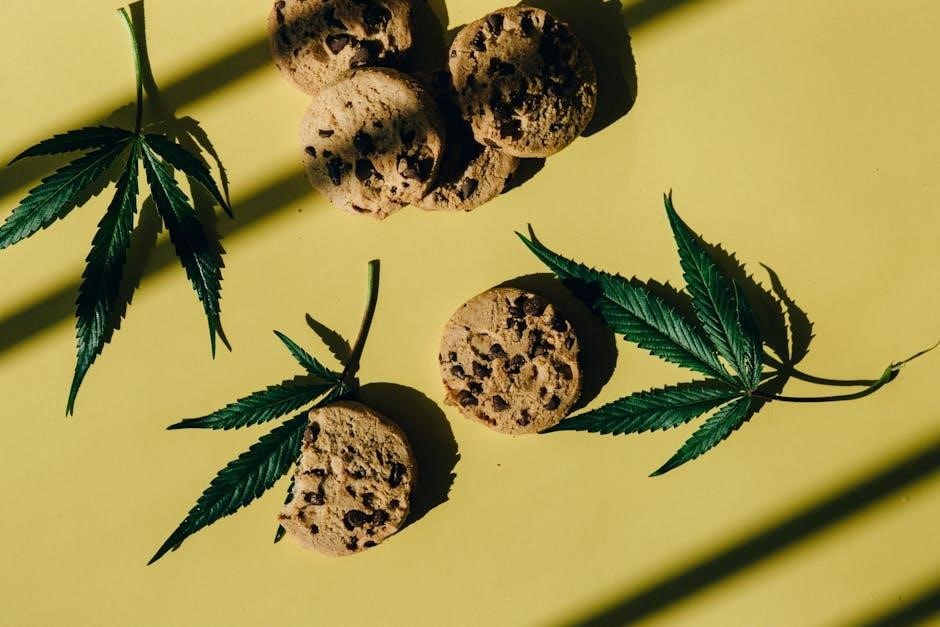
Understanding Edible Effects
Edible effects differ significantly from smoking cannabis due to digestion and metabolism. THC is absorbed through the liver‚ converting into a more potent form‚ 11-hydroxy-THC‚ leading to stronger and longer-lasting effects. Effects typically begin within 30–90 minutes and can last 4–8 hours‚ depending on dosage‚ metabolism‚ and food consumed.
The high from edibles is often described as more intense‚ with heightened sensory experiences‚ deep relaxation‚ and altered perception. Cognitive effects may include confusion or paranoia in high doses‚ while physical effects include body heaviness and reduced coordination; Emotional responses vary widely‚ ranging from euphoria to anxiety.
Individual tolerance plays a significant role. First-time users may experience overwhelming effects‚ while experienced consumers may find edibles milder. The ratio of THC to CBD also influences the experience‚ as CBD can mitigate THC’s psychoactive effects.
- Onset: Effects begin 30–90 minutes after consumption.
- Peak: Intensity reaches its highest point 2–4 hours after ingestion.
- Duration: Effects can last 4–8 hours‚ depending on dosage and individual factors.
Understanding edible effects is crucial for a safe and enjoyable experience. Start with low doses‚ wait patiently for onset‚ and plan activities accordingly to avoid discomfort or unintended situations.
Tips for First-Time Consumers
For first-time consumers of marijuana edibles‚ it’s crucial to approach with caution and mindfulness. Start with a low dose (10–20mg THC) to assess your sensitivity and tolerance. Edibles can be potent‚ and effects may take 30–90 minutes to manifest‚ so patience is key.
Always wait at least 60–90 minutes before consuming more to avoid overwhelming effects. Keep a trusted friend or family member nearby for support. Ensure edibles are stored safely and labeled clearly to prevent accidental ingestion by others‚ especially children.
Stay hydrated and have snacks on hand‚ as edibles can cause dry mouth and increased appetite. Avoid mixing with alcohol or other substances‚ as this can intensify unwanted side effects. Plan a quiet‚ comfortable environment where you can relax without responsibilities or stress.
- Begin with low doses to gauge your tolerance.
- Wait at least 60–90 minutes for effects to onset.
- Keep edibles in a secure‚ labeled container.
- Stay hydrated and have snacks available.
- Avoid mixing with alcohol or other substances.
Remember‚ edible effects can last 4–8 hours‚ so plan accordingly. If you feel uncomfortable‚ focus on deep breathing and remind yourself the effects are temporary. Most importantly‚ enjoy responsibly and prioritize your safety and well-being.
Managing Your Experience
Managing your experience with marijuana edibles is key to ensuring a safe and enjoyable journey. Start by setting a comfortable environment where you feel relaxed and secure. Begin with a low dose to gauge your sensitivity‚ as edible effects can be potent and long-lasting. If you feel overwhelmed‚ remember that the effects are temporary and will subside with time.
Stay hydrated by drinking water‚ and keep snacks nearby to manage hunger or dry mouth. Avoid consuming edibles on an empty stomach‚ as this can intensify effects. If anxiety arises‚ focus on deep breathing exercises or engage in calming activities like listening to music or taking a walk. Having a trusted friend or family member present can provide reassurance and support.
- Set a calm and familiar environment.
- Start with a low dose and wait for effects to onset.
- Stay hydrated and keep snacks available.
- Practice deep breathing if feeling anxious.
- Have a trusted person nearby for support.
Remember‚ edible effects can last 4–8 hours‚ so plan accordingly and avoid driving or operating machinery. If needed‚ over-the-counter antacids or ginger products can help with discomfort. Most importantly‚ approach edibles with mindfulness and prioritize your comfort and safety throughout the experience.
Storing Leftover Cannabis
Properly storing leftover cannabis is crucial to maintaining its potency‚ flavor‚ and overall quality. To preserve your cannabis‚ store it in an airtight container in a cool‚ dark place‚ such as a pantry or cupboard. Avoid exposure to direct sunlight‚ moisture‚ or heat‚ as these can degrade the cannabinoids and terpenes.
For short-term storage‚ glass jars with tight-fitting lids are ideal. For longer periods‚ consider vacuum-sealing the cannabis to prevent air exposure and humidity. If you live in a humid climate‚ using a desiccant or silica gel packets can help maintain dryness. Freezing is also an excellent option for long-term preservation‚ as it halts the degradation process. Simply place the cannabis in an airtight container or freezer bag and store it at 0°F (-18°C).
- Use airtight‚ opaque containers to block light.
- Keep in a cool‚ dark‚ and dry environment.
- Vacuum-seal for extended freshness.
- Freeze for long-term preservation.
- Label containers with the date and strain for easy identification.
Remember to store cannabis out of reach of children and pets to ensure safety. Proper storage not only maintains the quality of your product but also ensures a consistent experience when using it in future edibles.
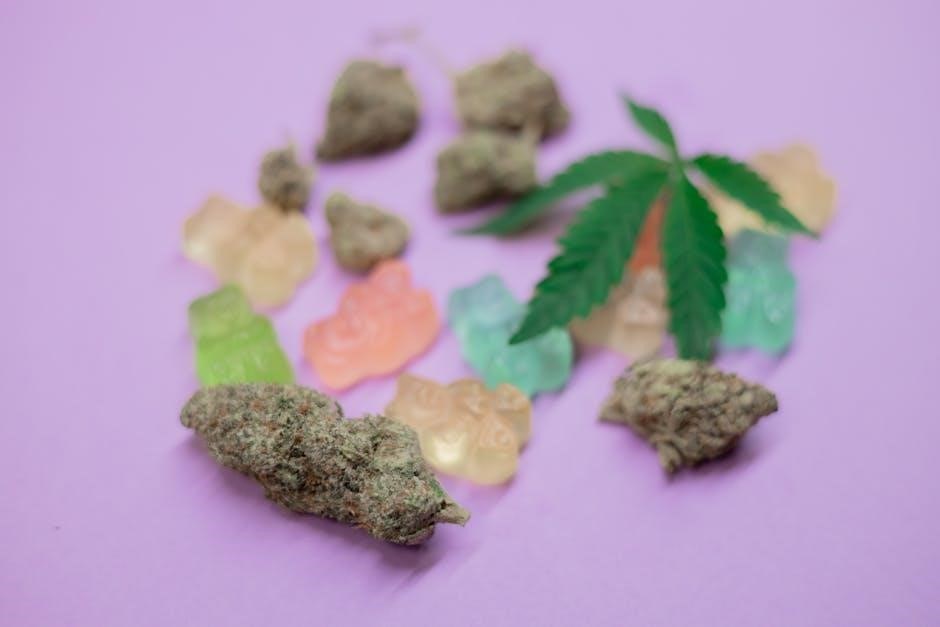
Advanced Techniques
Once you’ve mastered the basics of making marijuana edibles‚ it’s time to explore advanced techniques to elevate your creations. One method is precise THC measurement using lab-grade equipment to ensure consistent potency. Another is leveraging molecular gastronomy to infuse cannabis into unique textures‚ such as foams‚ gels‚ or pearls‚ adding a gourmet touch to your dishes.
Advanced infusions involve using high-quality cannabis extracts like rosin or CO2 oil for superior flavor and potency. Sous-vide infusions and vacuum-sealing techniques can enhance extraction efficiency while preserving delicate terpenes. Experiment with flavor profiling by pairing specific strains with complementary ingredients to create harmonious taste experiences.
- Use lab-grade equipment for precise THC measurement.
- Explore molecular gastronomy for unique textures.
- Infuse with premium extracts like rosin or CO2 oil.
- Experiment with sous-vide and vacuum-sealing methods.
- Flavor profile by pairing strains with complementary ingredients.
These advanced techniques allow for greater control over potency‚ flavor‚ and presentation‚ making your edibles stand out. Always prioritize safety and responsible practices when experimenting with new methods.
Troubleshooting Common Issues
When making marijuana edibles‚ encountering issues is common‚ but with the right troubleshooting‚ you can easily resolve them. One frequent problem is uneven potency‚ which often stems from improper decarboxylation or inconsistent mixing. To fix this‚ ensure your cannabis is fully activated and mix your infusions thoroughly before adding them to recipes.
Another issue is overpowering cannabis flavor. This can be masked by using strong-flavored ingredients like chocolate‚ citrus‚ or spices. If edibles are too potent‚ dilute them by increasing the serving size or adding more non-infused ingredients. Conversely‚ if they’re too weak‚ consider increasing the cannabis quantity or switching to a more potent strain.
- Uneven potency: Ensure full decarboxylation and thorough mixing.
- Strong cannabis flavor: Use bold ingredients to mask the taste.
- Too potent: Dilute by increasing serving size or adding non-infused elements.
- Too weak: Adjust with more cannabis or a stronger strain.
By addressing these common issues‚ you can refine your edible-making process and achieve consistent‚ enjoyable results. Remember‚ practice makes perfect‚ so don’t be discouraged by initial setbacks.
Health Benefits and Risks
Marijuana edibles offer therapeutic benefits for many users‚ including pain relief‚ reduced inflammation‚ and improved sleep quality. They can also stimulate appetite and alleviate nausea‚ making them popular among those undergoing chemotherapy. However‚ edibles carry risks‚ such as overconsumption‚ which can lead to anxiety‚ paranoia‚ or discomfort. The effects of edibles can vary widely based on metabolism‚ tolerance‚ and dosage‚ making them unpredictable for some users.
- Potential benefits: Pain relief‚ improved sleep‚ reduced nausea‚ and appetite stimulation.
- Risks: Anxiety‚ paranoia‚ impaired cognitive function‚ and dependency in heavy users.
- Special considerations: Accidental ingestion by children or pets‚ which can be dangerous.
Edibles may also pose risks for individuals with pre-existing mental health conditions‚ as THC can exacerbate anxiety or depression in some cases. Additionally‚ frequent use can lead to dependence or tolerance over time. To maximize benefits and minimize risks‚ responsible consumption and awareness of personal limits are essential. Always consult a healthcare professional before using edibles for medical purposes.
The Future of Edibles
The future of marijuana edibles is poised for significant growth and innovation. As legalization expands globally‚ the market for cannabis-infused products is expected to boom‚ with edibles playing a central role. Advances in technology‚ such as precise dosing tools and faster-acting formulations‚ are enhancing both safety and user experience. Companies are also exploring sustainable practices‚ such as eco-friendly packaging and ethically sourced ingredients‚ to meet consumer demand for environmentally responsible products.
- Increased accessibility: Edibles are becoming more mainstream‚ with diverse product lines catering to different preferences and needs.
- Technological advancements: Innovations in extraction methods and bioavailability are improving potency and consistency.
- Sustainability focus: Brands are prioritizing eco-conscious production and packaging to align with consumer values.
- Health trends: The rise of wellness-focused edibles‚ including products with non-psychoactive compounds like CBD and functional ingredients‚ is expected to grow.
Consumer education and transparency will also shape the future of edibles. As more people learn about proper dosing‚ potency‚ and safety‚ the stigma surrounding cannabis use is likely to decrease. With ongoing research and innovation‚ edibles are set to become a cornerstone of both recreational and therapeutic cannabis culture.
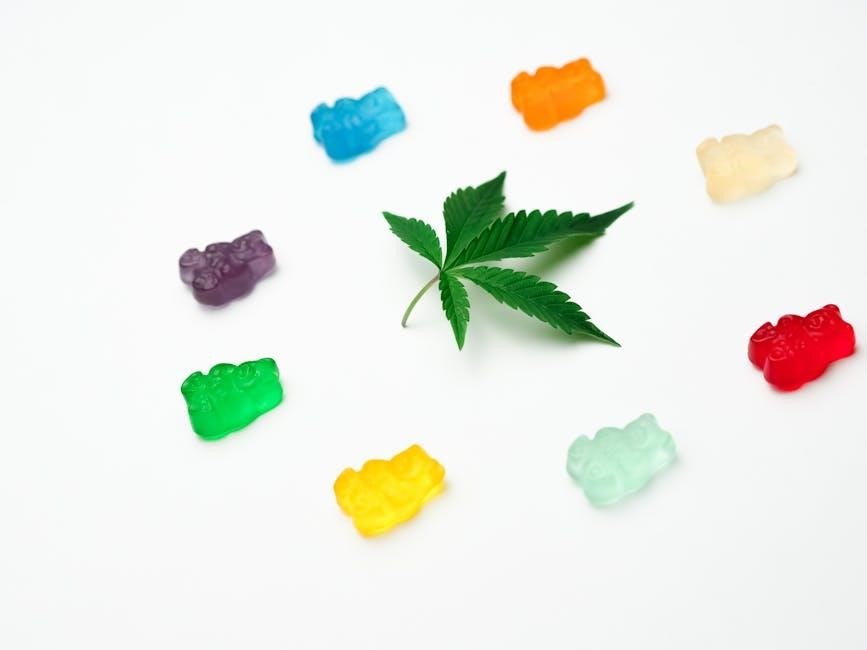
Sharing Edibles Responsibly
Sharing marijuana edibles responsibly is crucial to ensure a positive experience for everyone involved. Before offering edibles to others‚ consider their tolerance‚ preferences‚ and any potential sensitivities. Always disclose the THC content and ingredients used‚ especially if there are common allergens like nuts or dairy. This transparency helps others make informed decisions about consumption.
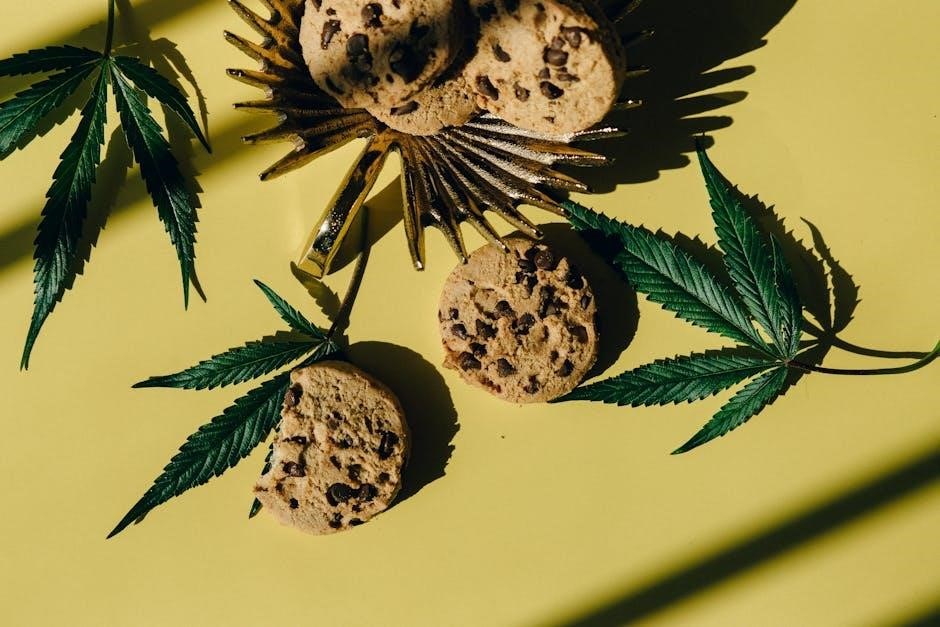
- Know your audience: Ensure the recipient is aware of the effects of edibles and has consented to try them.
- Start low: Encourage first-time users to begin with a small dose to assess their sensitivity.
- Label properly: Clearly mark edible products with THC content and ingredients to avoid accidental ingestion.
- Follow laws: Be aware of local regulations regarding the distribution and sharing of cannabis products.
Sharing edibles responsibly fosters trust and ensures a safe and enjoyable experience. By prioritizing open communication and consideration‚ you can help create a positive environment for cannabis use. Remember‚ it’s not just about sharing a product‚ but also about caring for the well-being of those you share it with.
Crafting marijuana edibles is a rewarding process that combines creativity with cannabis knowledge. By following the guidelines outlined in this guide‚ you can create delicious‚ potent‚ and safe edibles tailored to your preferences. Remember‚ patience and precision are key to achieving the best results.
- Start small: Begin with low-dose recipes to gauge potency and effects.
- Invest in quality: Use high-quality cannabis and ingredients for optimal flavor and potency.
- Label and store safely: Properly label and store edibles to prevent accidental consumption.
- Experiment wisely: Try new recipes and techniques‚ but always test potency before serving to others.
Edibles offer a unique way to enjoy cannabis‚ but they require responsibility and awareness. Always prioritize safety‚ legality‚ and the well-being of yourself and others. With practice and creativity‚ you can master the art of making marijuana edibles and enjoy the benefits they provide. Happy baking!
Additional Resources
For those eager to dive deeper into the world of marijuana edibles‚ there are numerous resources available to expand your knowledge and skills. From detailed guides to expert advice‚ these resources will help you refine your techniques and explore new ideas.
- Books: Titles like The Official High Times Cannabis Cookbook and Edibles: Small Bites for the Modern Consumer offer comprehensive guides and creative recipes.
- Websites: Platforms like Leafly and Weedmaps provide extensive information on cannabis strains‚ recipes‚ and dosing tips.
- Apps: Apps such as ReLeaf and High There! help track your cannabis use and offer insights for making edibles.
- Online Communities: Join forums like Reddit’s r/Edibles or r/CannabisCooking to share recipes and learn from experienced makers.
- Workshops: Attend local cannabis cooking classes or virtual workshops to gain hands-on experience and expert tips.
These resources will help you stay informed‚ inspired‚ and confident in your edible-making journey. Remember to always prioritize safety‚ legality‚ and quality in your creations!

